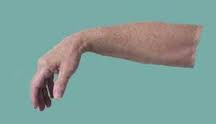
Radial neuropathy, also known as ‘wrist drop’ is a condition where the radial nerve is damaged leading to weakness in the wrist and fingers.
The radial nerve is formed from nerve roots exiting from the upper spinal cord. The nerve travels down the upper arm, at times very close to the humerus (upper arm bone). It then gives off several branches, the largest of which is known as the posterior interosseus nerve. The radial nerve may be damaged at the level of the humerus or in the elbow/forearm.
Patients with radial neuropathy will notice a weak wrist, which is often unable to be straightened. The fingers will also be weak, and may also be difficult to straighten (‘wrist and finger drop’). They may also notice weakness of the thumb, and if the problem is close to the origin of the nerve, a weak elbow. Numbness or tingling is often present over the back of the thumb, and sometimes the forearm.
Causes:
The nerve is usually damaged in one of two places:
Humerus (upper arm) – Fracture may cause a traumatic injury. The most common cause of a radial
neuropathy however, is sitting or sleeping with the arms over the back of the chair. This compresses the
radial nerve against the bone. It is often seen after heavy alcohol use where the patient may remain in
this uncomfortable position for a long time. It is for this reason that radial neuropathy is also called
‘Saturday night palsy’.
Forearm – The radial nerve may become trapped/damaged at the elbow by fractures, other injury or
repetitive use.
Tests:
If the patient wakes up with a non-traumatic radial nerve palsy, especially if they remember sleeping in a
chair, then no further tests are necessary. If there has been an injury to the arm, then the patient may
need an x-ray or further tests.
Treatment:
Non-traumatic radial nerve palsy has a good prognosis, and usually recovers over weeks to months.
Sometimes a wrist splint which
Non-traumatic radial nerve palsy has a good prognosis, and usually recovers over weeks to months. Sometimes a wrist splint which keeps the wrist in a straight position is useful as it places the hand in a better position for use.













